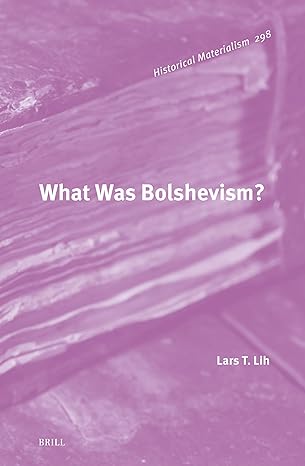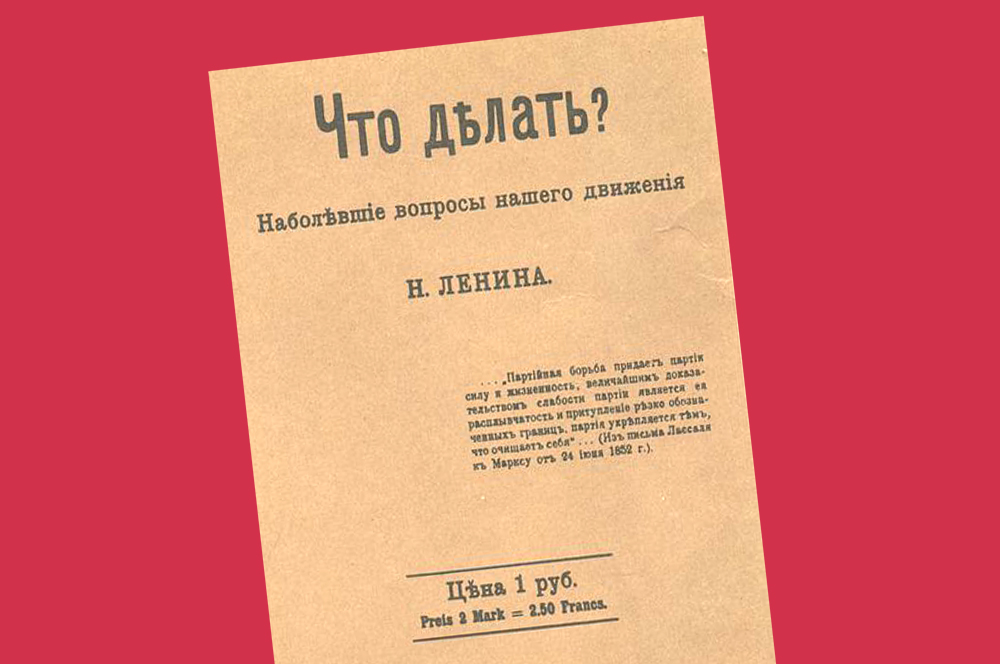Bolshevism Mystified

What Was Bolshevism?
by Lars Lih
Brill, 2023

Lars Lih is a scholar of Russian and Soviet history with expertise in the history and historiography of Russian Social Democracy. His first article saw the light in 1986. A book followed in 1990. Over the years, more articles and essays quietly appeared in a variety of specialist journals: Slavic Review, Russian History, Kritika, and others. Many are historiographical essays, often involving minute textual analysis and intricate lexical discussions of Russian terms accessible only to those with a working knowledge of Russian. They make up the bulk of What Was Bolshevism? The book therefore is not ‘straight’ history. Written by a specialist advancing apparently unconventional interpretations, Lih’s polemics often make for very difficult reading for those new to the field.
Lih became a sensation with the appearance of Lenin Rediscovered: What is to be Done? in Context in 2006. There he pilloried the “textbook interpretation” of Lenin’s idea of the revolutionary party as the progenitor of Stalinist tyranny. It was an instant hit on the left. In many essays, articles, podcasts, reviews and interviews, scores of socialist activists and Marxist academics, non-specialists for the most part, praised Lih’s intervention to the skies. A few gave reserved but sympathetic endorsements. In 2010, Historical Materialism organized a symposium on Lih; Science and Society followed suit in 2013. However, nothing similar occurred among proponents of the textbook interpretation. Beyond short book reviews, “respectable academia” organized no symposia or conferences. Lih’s introductory chapter to What Was Bolshevism? rehearses the essential themes of this multifaceted debate, and more.
Once again, Lih charges textbook interpreters with grossly misreading Lenin, Trotsky, Stalin and other Bolsheviks, of cherry-picking passages in their texts to fit the Cold Warrior’s pre-conceived, totalitarian notions of Bolshevism as the antechamber to Stalinism. This is especially true of WITBD. But Lih and his opponents largely agree on one thing: Both think WITBD was the foundational document of Bolshevism.
But Lenin did not think it was a foundational document at all, whether for good or evil. In 1907 Lenin explained the basic methodological mistake made by those who thought it was:
The basic mistake made by those who now criticise What Is To Be Done? is to treat the pamphlet apart from its connection with the concrete historical situation of a definite, and now long past, period in the development of our Party.1
Lenin denied the very premise tenaciously held by both sides of the divide: the fetishization of a text. For there is a deeply rooted tendency among historians, sociologists, political scientists and philosophers of all ideological outlooks to look for the Rosetta Stone of Bolshevism, key texts that can explain—or be made to explain—nearly everything. No such texts exist, whether it is WITBD or any of the thousands of interventions Lenin and other Bolsheviks wrote over their lifetimes. How do Lih and his critics, whether left or right, respond to Lenin’s less than pre-possessing characterization of WITBD? Though aware of it, they ignore Lenin’s admonition.
They ignore it because it goes against the world-historical significance both attribute to Lenin’s pamphlet. Both see the tree in the acorn: Lih—the Tree of Liberty (up to a point), Lih’s opponents—the Tree of Tyranny. In doing so, both warp the historical record beyond recognition. Below, I offer a synecdochical example of the speculative reasoning Lih deploys in his writings.
In 1892, Kautsky wrote The Erfurt Program. According to Lih, this book “defined Social Democracy for Russian activists—it was the book one read to find out what it meant to be a Social Democrat” (45). For Russian social democrats it meant
… the party inspires the Russian workers who inspire the Russian peasants to create together a worker-peasant vlast that will inspire the world by building socialism—this is the heart, the emotional core, of Bolshevism. (2)
Insofar as Lih here identifies a concrete political dimension to Bolshevik eschatology, every clause is materially incompatible with the “Erfurtian” politics of Western European social democratic parties.
Between 1903 and 1917, the Bolsheviks never thought a “worker-peasant vlast”—”worker-peasant power”—to build socialism was feasible in Russia, as Lih holds. Rather it was a vlast that would overthrow Tsarism in the bourgeois-democratic revolution, set up a revolutionary provisional government, and clear the way for the development of capitalism, not socialism. As valorous leader of the bourgeois-democratic revolution, the Russian Social Democratic Labor Party (RSDLP) would be in a position not merely to participate in a provisional government, but to assume revolutionary leadership of it. This vlast had a name and Bolsheviks called it the “revolutionary dictatorship of the proletariat and peasantry.”

This provisional dictatorship would secure the best political conditions for another vlast to convene. This vlast also had a name. Everyone called it the Constituent Assembly. Elected by universal, equal and secret suffrage, this worker/peasant dominated assembly would found another vlast, a permanent one. It had a name too: the democratic republic, the most democratic form of the capitalist state.
The democratic republic constitutionally secured, the RSDLP would dissolve the dictatorship of workers and peasants, go into opposition to the newly established bourgeois-democratic state, and become a party leading the workers’ movement toward socialism—just like those in the West. The peasantry does not enter the equation at this juncture because the rapid American style development of capitalism will transform this class of land possessors into landless proletarians. The road to socialism inevitably passes through a capitalist stage as an indispensable material prerequisite to socialist construction. Such was the essence of “Old Bolshevism.” This is how all Social Democrats understood matters—until 1917. This is how virtually every student of the period, whether newbie or not, has understood them as well.
In 1917 Lenin wrote the April Theses. He and his partisans called for a break with Old Bolshevism. The Bolsheviks “rearmed” the party and changed course, pushing for socialist revolution beyond the bourgeois-democratic revolution, adopting for all practical intents and purposes Trotsky’s Permanent Revolution outlook. But Lih denies discontinuity with Old Bolshevism. What does this mean? It must mean the Old Bolsheviks were partisans of permanent revolution from the very beginning, when they were Young Bolsheviks. What other meaning could it possibly have? Lih’s assertions that the Bolsheviks followed Trotsky de facto on this question before 1917 defy logic and the documentary evidence.
In sum, Russian Social Democrats faced conditions and objectives of political struggle under autocratic Russia that were qualitatively different from those in bourgeois-democratic states. These differences are immaterial to Lih because the social democratic party everywhere and at all times aspires to lead the working class wherever it exists, and no matter the kind of society it exists in. For him, Kautsky was the “architect” of the October Revolution. But if readers are to understand real history, these differences matter a great deal.
Broadly speaking, the terms Lih deploys in his work, especially untranslated Russian ones, are too often shifting or empty signifiers. Here, Lih’s vlast is an ahistorical abstraction from which no concrete vlast—provisional government, constituent assembly, democratic republic—can be derived—but which is compatible with any earthly manifestation of vlast.
There is a ‘benefit’ to this procedure. Using the same term allows Lih to convey identity and continuity to Bolshevik political doctrine “from its beginnings” (4). Since the Bolsheviks were always committed to “revolution do kontsa”—revolution to the end—Lih rejects the idea of rupture in Bolshevik doctrine in 1917, reading into the historical record a “deeper” continuity—just as the textbook interpreters do. The positive political values Lih attaches to this continuity are simply reversed in the textbook interpretation.
Lih asserts an “underlying continuity and gradual metamorphosis” of Bolshevism, from 1917 on. In other words, Bolshevism gradually became … Stalinism. There was no apocalyptic break between the two, as most revolutionary Marxists think. Both were predicates of “campaignism,” another term invented by Lih and hypostasized into a self-standing subject:
Bolshevik drive to overthrow absolutism was primarily fuelled by its desire to attain the political freedom needed for spd-style2campaignism; sadly, ‘state monopoly campaignism’ after October was a prime incentive to shut down political freedom in the Soviet Union. (6)
Under Lenin, party campaigns for popular support were not backed up by a state. The Bolsheviks were unarmed prophets. Under Stalin, they became armed prophets. If the people could not be convinced to go to the Promised Land, they could be coerced. The difference is no big deal for Lih. Such was the essence of Stalin’s 1938 Short Course on the history of Bolshevism. According to Lih:
The real hero of the Short Course is the Bolshevik party line. The party line, based solidly on a knowledge of the laws of history, is forced to fight against innumerable critics and scoffers from right and left and goes on from triumph to triumph—this is the narrative of the Short Course. And as it happens, Stalin was in fact almost always a conscious defender of the party line during Lenin’s lifetime (with a few small and unimportant exceptions). Of course, after Lenin’s death, Stalin was himself the principal architect of the party line. (517)
Lih declares that he does not give his “own answer” to What is Bolshevism? but the answer given by “authorized and authoritative Bolshevik spokesmen.” The considerations raised here should foster doubts about Lih’s self-assessment.
Opinions expressed in signed articles do not necessarily represent the views of the editors or the Tempest Collective. For more information, see “About Tempest Collective.”
Featured image credit: Picryl; modified by Tempest.
We want to hear what you think. Contact us at editors@tempestmag.org.
John Marot View All
John Marot is the author of The October Revolution in Prospect and Retrospect: Interventions in Russian and Soviet History. His articles have appeared in specialist journals and in socialist publications, Jacobin, New Politics, Against the Current, Historical Materialism and others.
